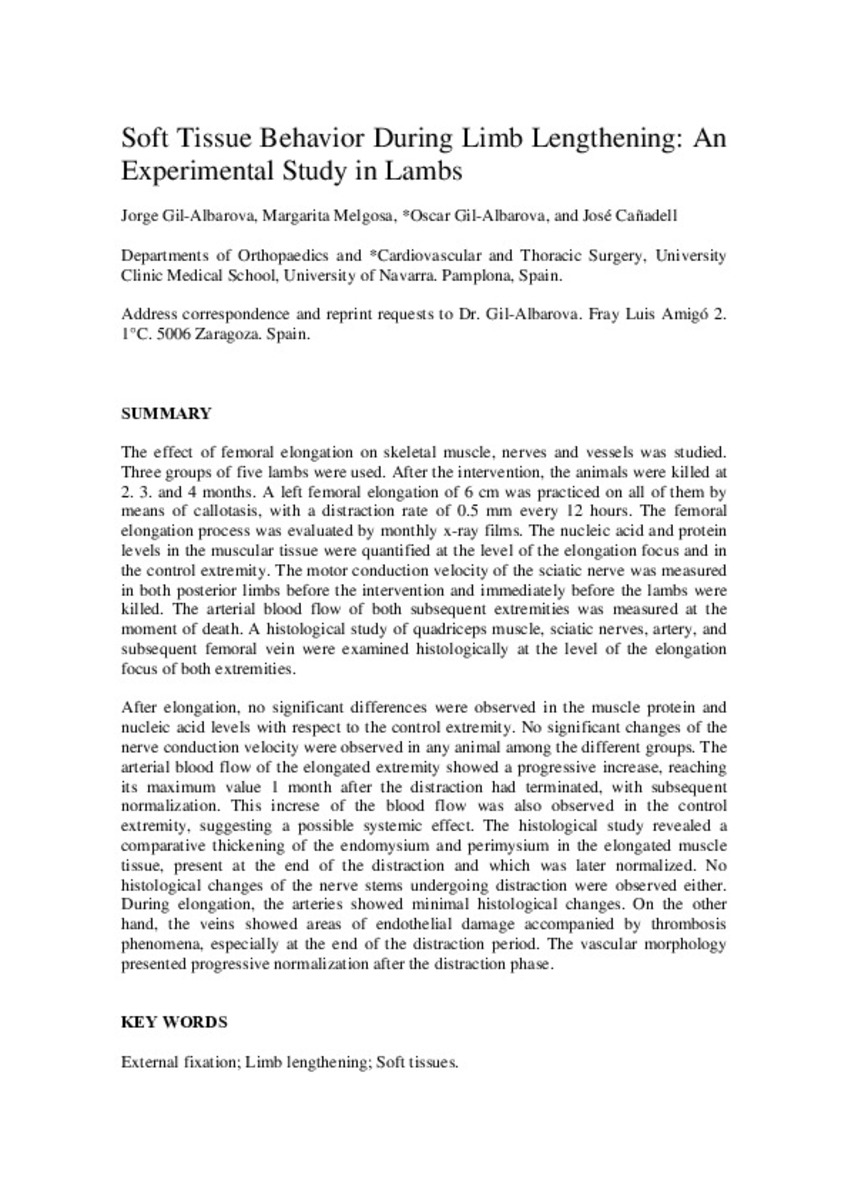Full metadata record
| DC Field | Value | Language |
|---|---|---|
| dc.creator | Gil-Albarova, J. (Jorge) | - |
| dc.creator | Melgosa, M. (Margarita) | - |
| dc.creator | Gil-Albarova, Ó. (Óscar) | - |
| dc.creator | Cañadell, J.M. (J. M.) | - |
| dc.date.accessioned | 2012-11-22T18:14:40Z | - |
| dc.date.available | 2012-11-22T18:14:40Z | - |
| dc.date.issued | 1997 | - |
| dc.identifier.citation | Gil-Albarova J, Melgosa M, Gil-Albarova O, Cañadell JM. Soft Tissue Behavior During Limb Lengthening: An Experimental Study in Lambs. J Pediatr Orthop B. 1997 Oct;6(4):266-73. | es_ES |
| dc.identifier.issn | 0271-6798 | - |
| dc.identifier.uri | https://hdl.handle.net/10171/23784 | - |
| dc.description.abstract | The effect of femoral elongation on skeletal muscle, nerves, and vessels was studied. Three groups of five lambs were used. After the intervention, the animals were killed at 2, 3, and 4 months. A left femoral elongation of 6 cm was practiced on all of them by means of callotasis, with a distraction rate of 0.5 mm every 12 hours. The femoral elongation process was evaluated by monthly x-ray films. The nucleic acid and protein levels in the muscular tissue were quantified at the level of the elongation focus and in the control extremity. The motor conduction velocity of the sciatic nerve was measured in both posterior limbs before the intervention and immediately before the lambs were killed. The arterial blood flow of both subsequent extremities was measured at the moment of death. A histological study of quadriceps muscle, sciatic nerves, artery, and subsequent femoral vein were examined histologically at the level of the elongation focus of both extremities. After elongation, no significant differences were observed in the muscle protein and nucleic acid levels with respect to the control extremity. No significant changes of the nerve conduction velocity were observed in any animal among the different groups. The arterial blood flow of the elongated extremity showed a progressive increase, reaching its maximum value 1 month after the distraction had terminated, with subsequent normalization. This increase of the blood flow was also observed in the control extremity, suggesting a possible systemic effect. The histological study revealed a comparative thickening of the endomysium and perimysium in the elongated muscle tissue, present at the end of the distraction and which was later normalized. No histological changes of the nerve stems undergoing distraction were observed either. During elongation, the arteries showed minimal histological changes. On the other hand, the veins showed areas of endothelial damage accompanied by thrombosis phenomena, especially at the end of the distraction period. The vascular morphology presented progressive normalization after the distraction phase. | es_ES |
| dc.language.iso | eng | es_ES |
| dc.publisher | Lippincott, Williams & Wilkins | es_ES |
| dc.rights | info:eu-repo/semantics/openAccess | es_ES |
| dc.subject | Femur/surgery | es_ES |
| dc.subject | Hindlimb/innervation/physiopathology | es_ES |
| dc.subject | Muscle, Skeletal/pathology/physiopathology | es_ES |
| dc.title | Soft Tissue Behavior During Limb Lengthening: An Experimental Study in Lambs | es_ES |
| dc.type | info:eu-repo/semantics/article | es_ES |
| dc.type.driver | info:eu-repo/semantics/article | es_ES |
Files in This Item:
Statistics and impact
Items in Dadun are protected by copyright, with all rights reserved, unless otherwise indicated.






